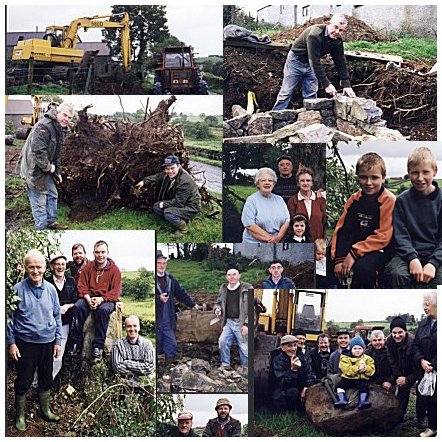Ballymacpeake Mass Rock
Fr O'Donnell PP. Fr McLaughlin and altar servers at the Mass Rock 2003 AD

Photo above Courtesy of WJ McCann






2003
Mass - Sunday 17th August 2003 AD
The Ballymacpeake Mass Rock
restoration Project.
How 'Mass Rocks' are renewing the Faith in Ireland - ACH USA


'How many and varied the places
where Mass has
been offered - in stately medieval and in splendid modern cathedrals; in early
monastic and in modern churches; at Mass rocks in the glens and forests by
"hunted priests" and in poor thatch-covered chapels for a people poor in worldly
goods but rich in the things of the spirit; in "wake-houses" or
"station-houses", or at great open-air hostings of the faithful - on the top of Croagh
Patrick and at Lough
Derg. Small matter where the Mass was offered. For the Irish, it was always
the Mass that mattered'.
Pope John Paul II, Dublin, 29th September 1979.
The Story.
The first task was to contact the local owner of the land on which the stone lay. He was immediately enthusiastic and has since personally taken on the building work associated with this memorial. The next task was to remove a large Beech tree which had grown over the stone for many years and was at this stage embedded in it's roots. The tree bounded a small country road and with the aid of a professional chainsaw operator and a heavy tractor it was felled one wet and windy day into an adjoining field. An excavator then pulled the tree root out leaving the stone completely intact. The landowner agreed to locate the stone in its existing postion and thus a foundation was dug out to accommodate a memorial. A few days after, a local JCB arrived and using ropes the stone was slung into postion on a newly built plinth.
An engraved memorial tablet has now been put in place. Paving stones have been put on the floor of the memorial. A small Penal Cross found some years back in the vicinity of the rock has now been traced after Peter Hughes (RIP) suggested an appeal in The Irish News.
Local people have contacted the Committee about memories of the Altar Stone, one of these a man in his nineties recalls his teacher, Master Toner taking him and his class from Ballymacpeake school to the site of the stone. .
The Committee would be grateful for any information or stories about this stone. If anybody has anything of interest to offer then please email me.

Mass Rock Inscription stone arrives. (22nd April 2000)


Donal and John Joe survey the results of a good day's work. A small holy water font has also been placed next to the Mass Rock.


Extract from the autobiography of William Carelton, Ireland, (1794 - 1869)






















